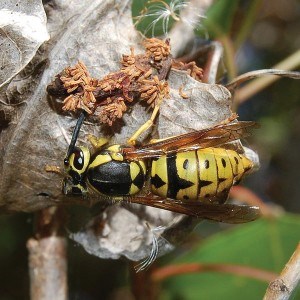
Although the first frosts of the fall have brought an end to this year’s abundant wasp population, for many, the redness and pain of late-summer stings still lingers. Stories of swollen lips and hasty picnic endings abound, and suggest Jasper had a wasp year unlike any in recent memory.
Why so many? Dr. Matthias Buck, assistant curator of Invertebrate Zoology at the Royal Alberta Museum says, “Although there are no easy rules to predict a wasp population, there are certain conditions that are favourable.”
“Cold and wet years limit the time wasps can be out foraging,” he explains. As wasps rely on external temperatures for body heat, cold days can slow them down. “When the wasps forage less, they raise less brood.”
Environment Canada data shows that July in Jasper was warmer than average, and that the amount of rainfall in late spring and early summer was well below average. These conditions would definitely favour wasp populations. However, like all things in the natural world, it’s rarely that simple.
For example, some research indicates that in temperate climates like ours, mild winters also play a role in promoting wasp populations. Most wasps die with the onset of cold weather in the fall. However, new queens hibernate through the winter tucked beneath the bark of dead trees, under leaf litter, or in the outer walls of your house. In the spring, the queen will build a nest, and by late summer, a healthy yellow jacket colony can have thousands of workers. In Jasper, the past winter provided few cold snaps to limit the number of queens, and it’s likely many survived to start colonies this spring.
Buck suggests drought can also affect wasps. “If there is a drought, vegetation doesn’t do well, and herbivorous insects don’t do well either. This diminishes the prey available for wasps.”
Then there is the sheer number of species, all of which behave and adapt slightly differently. The term “wasp” is often used to refer to wasps, yellow jackets, and hornets. Some are solitary, and some live in colonies. Some build aerial nests on tree branches or under the eves of buildings, but many wasps conceal their nests in old tree stumps, natural crevices and under porch steps. Buck says, “The trouble-causing species are the ones that tend to build [nests] in the ground.”
He is referring to yellow jackets. There are 14 species of these yellow and black-striped stingers in Alberta. “That’s quite a lot,” says Buck. “In the southern United States you may only have two or three species.”
Most yellow jackets build ground nests, although at least one species in Jasper builds small, circular paper nests under the eves of buildings. They are attracted to sugary drinks and snacks at a picnic, as adults naturally feed on sugars like those found in flower nectar. Adults are also responsible for bringing protein back to the brood in the colony. Buck says most yellow jacket species are strictly predators; killing other insects and bringing them back to the nest. However, there is one species that will scavenge for meat, and can be quite aggressive about it. It will come to the barbecue for the sugar and the hamburger.
Wasps can be helpful in that many feed on plant-eating insects and nuisance flies. Like all predators at the top of the food chain, they are important in controlling the number of prey species and keeping their populations in check. Wasps also serve as pollinators.
Still, it’s not fun to be swarmed every time you crack a ginger ale, and people have resorted to all kinds of deterrents. Some have turned to hanging up artificial paper wasp nests, based on the theory that wasps are territorial and will not build a nest close to another. At this point, there is little scientific evidence to support this. Consider the fact that an aerial nest may not be much of a visual deterrent to species that nest in the ground.
If you want to deter yellow jackets from attending the party, the Royal Alberta Museum website recommends that you don’t wear perfume and colognes, as wasps are attracted to anything that smells like flowers. For the same reason, they will be attracted to brightly coloured clothing or floral prints. The rest is intuitive: avoid eating and drinking sweets outside in late summer and early fall, when yellow jackets are most aggressive. Remember to check inside the beer or pop can before taking a swig. As too many of us have learned, it is not uncommon to be stung in the mouth this way. If you do come across a nest, avoid disturbing it, as workers will likely defend it. If you step on or bump into a nest accidentally, Buck recommends that you “run away as fast as you can.”
Niki Wilson
Special to the Fitzhugh
